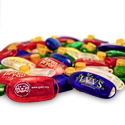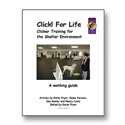How the Upper Valley Humane Society (UVHS) uses targeting to help shy dogs develop confidence.
Shy dogs are an especially difficult challenge in the shelter environment because it is so hard for them to establish trust. We have found that teaching these dogs to target our hand can help many shy dogs develop confidence with people fairly quickly. You can't begin to try this method until there is at least one person (staff or volunteer) the shy dog has a little trust in.
Target training teaches the dog to touch his nose to some object or person for a click and then treat. (If the shy dog is very noise reactive, you may choose to use a "soft" voice marker or a muffled clicker)
We begin with the "trusted" person teaching this behavior.
- The trainer squishes the smelly food treat into the space between the second and third fingers down near the palm of their hand.
- Standing sideways with the target hand nearest the dog, the trainer waits for the dog to sniff her hand. When he sniffs, he gets a click or "Yess" and then can lick out the treat from between the fingers or she can just open her fingers and let the treat fall to the ground. This step is repeated 10-15 times.
- Then the food reward is removed from the hand and you begin again. When the dog sniffs/touches your hand, he is clicked and treated BUT now the treat comes from the other non-target hand. If the dog is confidently reaching out to touch your hand, then start moving the hand a little so his nose has to follow it before the click/treat. This step is repeated until the dog can follow your hand around the building in all directions. Before moving to #4 the dog should be able to "touch" repeatedly before the click/treat. The "touch" to your hand should be a nice strong push, not just a soft touch.
- The next step involves having the dog transfer the target to an object. A chair works great for this step. For some dogs you may need to help them at first by going back to putting a treat between your fingers. Rub the treat on the surface of the chair and lead the dog's nose to chair with your smelly target hand. Click when his nose touches the chair. When the dog gets the idea of touching the new object with his nose you can begin to work on sending him from greater and greater distances. Once the dog becomes "hooked" on touching his nose to the target it's time to take it on the road.
- Your shy dog should be confident enough about what he gets for targeting that you can try making a "new" person target. This stranger needs to be careful not to make any eye contact and to be relaxed, sideways to the dog, and maybe even to yawn! Have the stranger sit in the chair with its hand down by one side with the palm outwards. The yummy treat is squished between two fingers, but is easy for the dog to lick out. Don't click when the dog takes a treat. Just let him make his own approach, replace each treat until he has taken a treat from the stranger 10 times.
- Now the stranger has NO treat in her hand. You should be standing still just looking and calmly talking to the stranger. Wait for the dog to "touch" the stranger's now empty palm. Click/treat for the touch. As soon as the dog finishes his treat, ask for "touch". If the dog goes to the stranger's palm, click and a big jackpot would be well deserved. Build on targeting stranger's hands - changing posture, location, gender, etc. Targeting a hand make contacting strangers a comfortable behavior providing us with a positive way to reward social interaction.
- Be sure to take your targeting outside. Start someplace safe, then go on walks. Have other volunteers come up and have your dog target their hand. Remember, when you're first training in a new environment you may need to go back to the first step for a while until your dog can perform the behavior reliably. Never be afraid to back up! Fearful dogs have a much harder time becoming operant. Much of the environment is aversive to them which is why developing a reward for touching through targeting the hand gives you a way to move them around the environment and feel safe and reinforced. Don't expect too much too soon.
An interesting experience with 3 shy shelter dogs:
One day during a staff training session, I had the three of our shelter kennel staff (because they have the closest relationship) bring three fearful dogs into the training center. I then had the rest of us (14 people) sit on the training center floor in a big semi circle. We sat front to back in a circle so one shoulder faced out. Everyone had some nice smelly hotdogs.
None of these dogs had ever been in the building so simply entering the building was a scary challenge. The boldest of the three, "Justine," made it into the large training room and as soon as she smelled the treats she was just walking around the circle, wagging her tail and unconcerned. Food was definitely working for her. Then I had everyone put out their outside hand palm up close to the floor. The dog then started touching their hand to investigate it and I would click and they would treat! At this point I had the handler unleash her. Come to find out she knew some really cute tricks. She could dance around in a circle and wave while sitting up. Just really cute!!
The next 4-month-old puppy "Cookie" was really afraid. I had this handler sit on the floor and just start clicking any brave forward motion. Of course she immediately started verbally cueing to the puppy "its ok"! So I asked her to please not speak to the puppy, just click. The puppy then started following the other dog around and her body posture started changing. Yippee! We were on a roll.
The third dog "Solomon" couldn't muster up the strength to come in the front door so his handler (who is one of our trainers too) just let the young dog walk around and build up his confidence. They ended up coming in through a garage door instead of the front door, which was great thinking! Now they are in an adjacent room to all of us with viewing windows. Dave just sat down to watch and the young dog came up and sat on on his lap. The windows between the two rooms can slide open; and soon Dave stepped through the window. The young dog watched from the chair for a while and then jumped through the window to be with everyone. He never looked back once he knew the other dogs were getting something he wasn't. He began cruising around the room grabbing treats. At this point (about 10 minutes of sitting on the floor) we all stood up. This scared "Cookie" the 4-month old a bit, but once she saw that the other dogs were ok with us standing she started to move around the room and following the other two.
Once we were standing, we started calling the dogs by name only. Soon all three were running back and fourth when called to all 18 of us, including Dave and his three kennel staffers! What a sight. Wish we had it on tape!
These three dogs made tremendous strides in less than 30 minutes. I think it worked so well because:
- All the dogs were good together.
- One dog was only cautious, not seriously shy, so the presence of the food overrode her fear quickly. Once "Justine was acclimated she provides a "role" model for the others. In my opinion Selecting a "nurse" dog leader would be important to the overall success. (Looking back on this, if the first one had stayed scared I don't think we would have been so successful).
- Having all the humans sitting sideways made them as easy to approach as possible.
- Clicking by the kennel staff helped too. They already had a relationship with these dogs/puppies.
Teaching your dog to target and getting him really hooked on it will give you a tool to deal with fearful episodes. The targeting behavior must be really fun and really well learned for this to work. Have new "scary" people sit side ways to the dog at a distance. Have them put their hands palms outward at their sides. With the dog on a leash allow him to investigate at his own speed. The person should completely ignore the dog, no eye contact, no reaching to pat, no talking. The handler should click and treat any movement toward the person first, with the goal being for the dog to get closer and closer to the person's hand. The person can hold a delicious treat in their hand to help encourage the dog once the dog is touching the hand readily. The handler should still do the clicking, and let the stranger do the treating. Changing the person's position, having them stand and move around can be added later.
Some people find when the dog is really hooked on targeting that this whole process moves very rapidly. We once had a dog in class that was terrified of a plastic pool that someone had placed on the ground. This dog was using the targeting behavior in our agility class and loved the game. Within about five minutes, this dog that was initially terrified of the plastic pool was poking it with her nose, then stepping inside of it quite happily. Her owner can now use this targeting behavior whenever her dog's confidence wavers and immediately get her right on track.
Dee Ganley CPDT, Training Center Manager
Nancy Lyon, Trainer
Upper Valley Human Society 2002
Related Products
|
|
|










Shy with other dogs
Thank you. I'll try my retired racing greyhound with this as she is very shy of strangers. However, she is also afraid of most other dogs. We've had her 10-weeks (and thanks entirely to clicker training she has excellent recall). She gets on brilliantly with a male Saluki I go for walks with; they play chase and can play quite roughly which she's fine about. She will also chase after border collies that are chasing their ball (probably because they're not interested in her). When we first had her she had just come out of her season and so attracted a Labrador and a smaller mongrel - she ended up leaping and banging against us to get out of their way (the owners had no control over their dogs). We squirted the dogs with water on subsequent walks and they soon learnt to ignore her. Now that she can be let of the lead, she will run the other way when she sees another dog, and if the dog isn't too fussed about chasing after her she will wait a distance away from the other dogs. If she comes near me, I click her, but have to treat her later because she soon runs off again. How do I get her to be more confident around other dogs? She can easily out-run them all. I'm careful to only let her off in safe areas where she is far from a road, but I'd feel much happier if I was confident that she wouldn't just keep running in the opposite direction for as long as the dog will chase her. If she sees another dog, she won't let me put her on the lead (even though she's fine for me to do this at all other times).
Post new comment